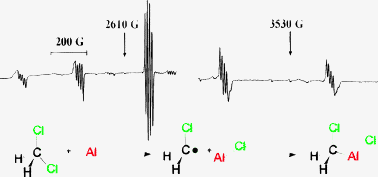Activation of C–Cl by ground-state aluminum atoms: an EPR and DFT investigation
Abstract
The reaction of ground-state Al atoms with

* Corresponding authors
a
Department of Chemistry and Biochemistry, Laurentian University, Ramsey Lake Road, Sudbury, ON, Canada
E-mail:
hjoly@laurentian.ca
Fax: 705-675-4844
Tel: 705-675-1151 ext. 2333
The reaction of ground-state Al atoms with

 Please wait while we load your content...
Something went wrong. Try again?
Please wait while we load your content...
Something went wrong. Try again?
H. A. Joly, T. Newton and M. Myre, Phys. Chem. Chem. Phys., 2012, 14, 367 DOI: 10.1039/C1CP22398D
To request permission to reproduce material from this article, please go to the Copyright Clearance Center request page.
If you are an author contributing to an RSC publication, you do not need to request permission provided correct acknowledgement is given.
If you are the author of this article, you do not need to request permission to reproduce figures and diagrams provided correct acknowledgement is given. If you want to reproduce the whole article in a third-party publication (excluding your thesis/dissertation for which permission is not required) please go to the Copyright Clearance Center request page.
Read more about how to correctly acknowledge RSC content.
 Fetching data from CrossRef.
Fetching data from CrossRef.
This may take some time to load.
Loading related content
